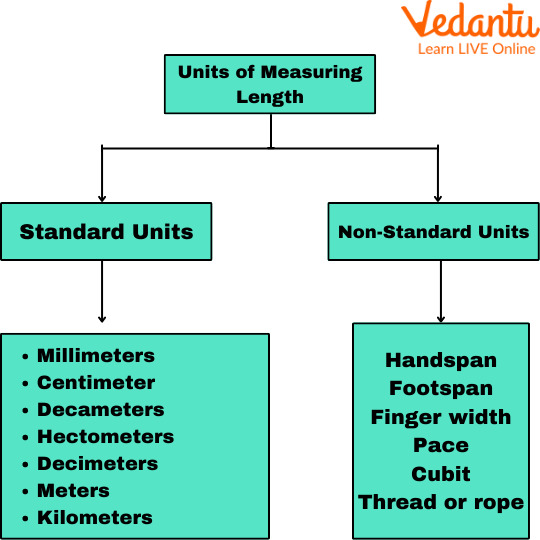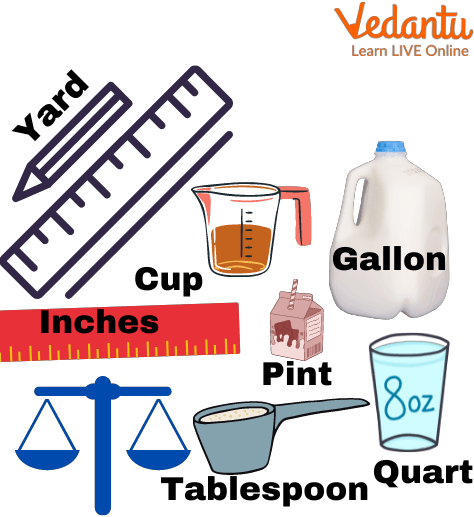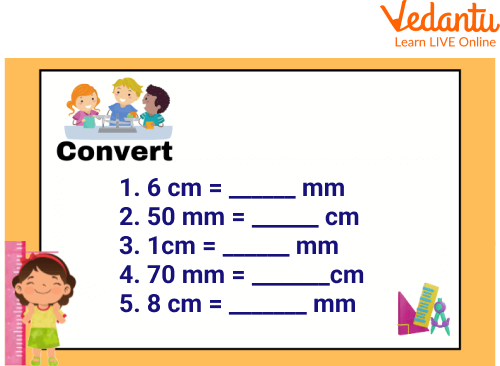




Key Measurement Concepts and Sample Questions for Class 2
Have you ever wondered why we use a certain unit to compare to objects? Like if we want to measure the size of a notebook, we use a scale and measure it in centimeters or inches but we do not use liters or milliliters to measure the length. So what is measurement? It is the comparison of an unknown quantity with a known quantity. The outcome of the measurement is a numeric value with specific units. We can measure the length, mass, capacity(volume), and temperature of any given object using measurement. So in this article, we will learn about measurement, and how we can solve measurement questions for class 2 by solving measuring worksheets for 2nd grade.
What is Measurement?
Measurement is the act of measuring. It can be understood as a process of defining physical items using numbers. Daily work becomes easier when we know how to measure things, and that is why measurement is a valuable thing to do. Now let's learn more about the units by solving measurement worksheets for 2nd grade.
Measuring Units
Measuring units are classified into two categories as given below:
Standard unit of measurement
A standard unit of measurement is a measurement that enables everyone to understand the object's relationship to the measure. It can be indicated in terms of inches, feet, kilometers, and meters.
Non-Standard Units of Measurement
In the early days, measurement was done by estimation of body parts, but they weren't accurate because if we use our hand span to measure length, the measurement taken by a different person will vary as our hand spans are not equal. So, hand spans are not standard units of measurement.

Units of measuring length
Measuring Tools
Measuring tools that can be used by kids are given under:
Thermometers rulers
Yardsticks
Scales
Beakers
Protractors
Clocks
Measuring tape
Forms of Measurement
Three Forms of Measurement, generally used are given as follows:
Capacity
The amount that something can hold is defined as its capacity. It typically refers to volume, as in milliliters (ml) or liters (l). A Cup of glass, for example, has a capacity of 500 ml (but is holding only 100 ml). Capacity refers to someone or something's ability to hold something, such as how many pencils can fit in a packet or how much milk a jar can hold.
Weight (Mass)
The mass of an object is a measure of how much matter it contains. An iron ball, for example, is quite small but has a mass of 1 kg, indicating that it contains a lot of matter. The weight of something is commonly used to determine its mass. However, weight is caused by gravity, whereas your mass remains constant. It is expressed in grams, kilograms, and tonnes.
Length
The greatest extent of anything in length. It can be measured in terms of meters, centimeters, decametres, kilometers, etc. The length of a pencil is approximately 10 cm, while that of a sharpener is about 3 cm.
We will further learn about these by solving centimeter worksheets for 2nd grade

Measure units
Solved Examples
Q 1. Convert 5 kg into grams
Solution: We know that 1 kg =1000 g
As we wish to find more number of kg, so we use multiplication, i.e.
We multiply 1000 g by 5 kg
5 x 1000 g
= 5000 g
Thus 5 kg equals 5000 g.
Q 2. Convert 4l into ml
Solution: We know that 1ltr =1000ml
As we wish to find more numbers of l, so we use multiplication, i.e.
We multiply 1000 ml by 4 l
4 x 1000 ml = 4000 ml
This 4 l equals 4000 ml.
Q 3. Convert 2m into cm
Solution: We know that 1m =100 cm
As we wish to find more numbers of m, so we use multiplication, i.e.
We multiply 100 cm by 2 m
2 x 100 cm = 200 cm
Thus 2 m equals 200 cm.
Practice Measurement Questions for Class 2
Q 1. Convert the following into milliliters:
7l =_______
Ans: 7000 ml
12l =_______
Ans:12000 ml
Q 2. Convert the following into grams.
(i) 14 kg=________
Ans: 14000 g
(ii) 3 kg =________
Ans:3000 g
Measurement Assessment 2nd Grade
Q 1. Mrs Reddy's dogs weigh 5kg. What is the weight of the dog in g?
Ans: 5000 g
Q 2. A doctor prescribed Mr Roy a 500 mg tablet. How much is that in g?
Ans: 0.5 g
Q 3. Kayra’s sharpener has a mass of 20 g. How much is that in mg?
Ans: 20,000 mg
Measurement Worksheets Grade 2

Centimetre worksheets for 2nd grade
Summary
In this article, we learned about how measurement quantifies the properties of an object or event, allowing us to compare it to other things or events. When dealing with the division of a quantity, the most commonly used word is "measurement". Measuring units along with measurement tools are discussed to clarify the concepts. Some centimeter worksheets for 2nd grade, along with measurement assessment 2nd grade and measurement questions for class 2 are discussed for a better understanding of the concepts.
FAQs on Measurement Questions For Class 2: Practice & Solutions
1. What are measurement questions for Class 2?
Measurement questions for Class 2 help students understand length, weight, and capacity. They include problems like comparing object sizes, measuring using a ruler, and choosing appropriate non-standard units such as hand spans or paper clips to practice the concept of measurement.
2. What is non-standard measurement in Class 2?
In non-standard measurement, students measure objects using items like pencils or cubes instead of rulers. For example, if a book is five pencils long, pencils are the measuring unit. This helps kids grasp the basic idea of length and measurement before using standard units.
3. How do Class 2 students compare lengths?
Class 2 students compare lengths by directly matching objects or using units like erasers. They learn to use words such as ‘longer’, ‘shorter’, or ‘equal’ to describe the relationship between lengths of two or more objects in simple measurement questions.
4. What units of measurement are introduced in Class 2?
In Class 2, students learn both non-standard units (like finger widths) and standard units such as
- centimeters (cm)
- meters (m)
- liters (L)
- kilograms (kg)
5. Why is measurement important for Class 2 students?
Measurement teaches Class 2 students practical math skills needed in daily life. It helps them understand size, height, and quantity, and prepares them for advanced topics by giving real-world context to classroom learning in measurement questions.
6. What is the difference between length and weight in measurement?
Length shows how long something is, measured in units like centimeters or meters. Weight shows how heavy something is, measured in grams or kilograms. Both are important parts of measurement for Class 2 students, but they measure different properties.
7. How do students measure capacity in Class 2?
Class 2 students learn to measure capacity (the amount a container holds) using standard units like liters (L). They may also use non-standard objects such as cups or spoons to fill containers, helping them relate measurement to real-world situations.
8. What common tools are used for measuring in Class 2?
Students use rulers for length, balances for weight, and measuring cups or bottles for capacity. They may also use everyday items for non-standard measurement. These tools help make measurement questions practical and easy to understand.
9. Can you give an example of a simple measurement question for Class 2?
A simple measurement question for Class 2 might be: “Which is longer—your pencil or your eraser?” or “How many paper clips long is your notebook?” These questions help students compare lengths and use measuring tools to find answers.
10. How do students estimate measurements in Class 2?
Class 2 students estimate measurements by guessing an object’s length or weight before actually measuring it. They use experiences and visual clues to estimate, then check their answers using rulers or balances, which builds their understanding of measurement concepts.
11. What math operations are used in Class 2 measurement questions?
Measurement questions for Class 2 often involve addition and subtraction of measured lengths, weights, or capacities. For example, adding the lengths of two ribbons or finding how much heavier one object is compared to another using subtraction: $\text{Difference} = \text{Heavier Object} - \text{Lighter Object}$.





















